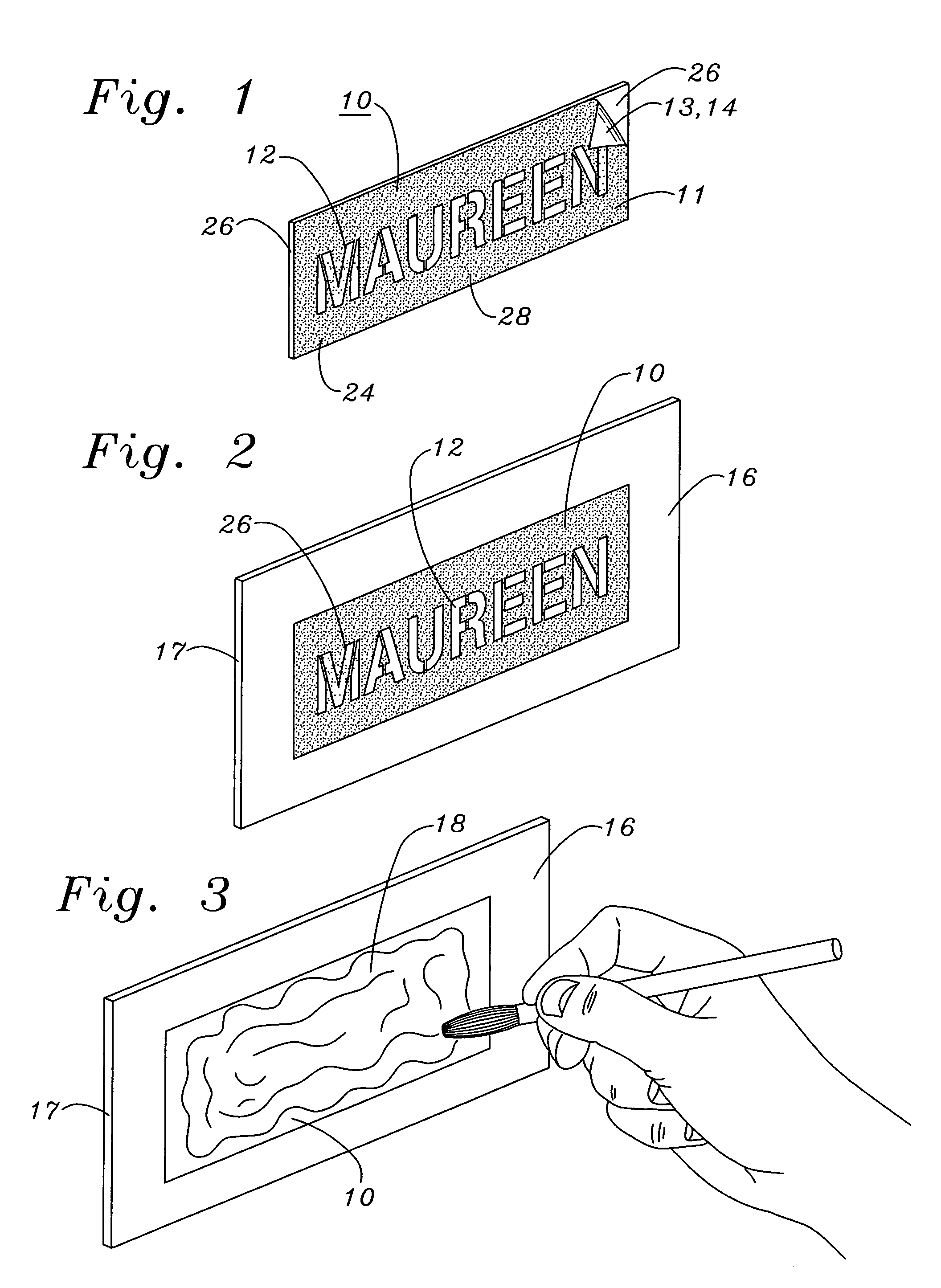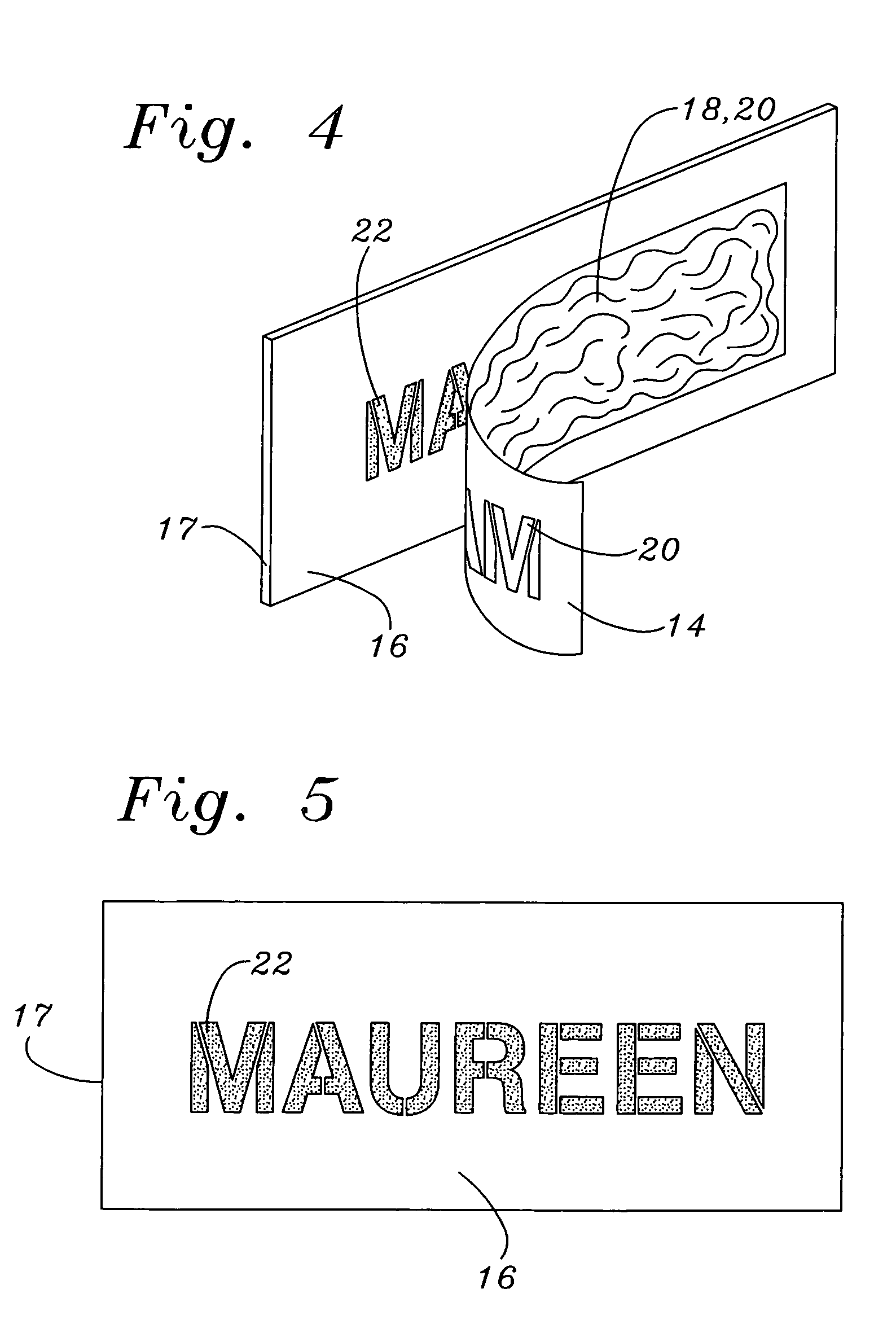Peelable stenciling ink and method of using
a stenciling ink and peeling technology, applied in the field of peeling stenciling ink and peeling penetrating ink, can solve the problems of increasing the possibility of loss or theft, reducing the number of work, and not economically practical solutions for individuals' personal identification needs, and achieve the effect of sufficient time for solven
- Summary
- Abstract
- Description
- Claims
- Application Information
AI Technical Summary
Benefits of technology
Problems solved by technology
Method used
Image
Examples
example 1
[0112]A dye stenciling ink was first prepared using the following procedures. To about 55 grams of toluene was slowly added 10 grams of ethyl cellulose under vigorous mixing and stirring at room temperature. The mixing was continued until the ethyl cellulose had substantially gone into solution. The mixing was accomplished by using a hand held mixing instrument. The ethyl cellulose employed here was labeled EC N 20 obtainable from the Hercules Company of Wilmington, Md. The material is available in fine white granules. About 4 grams of dye is added to the mixture under vigorous stirring for several minutes to achieve a uniform dispersion of the dye.
[0113]A suitable dye is an azo class dye such as that commercially available from Chemserve Corporation of Detroit Mich. under the name Solvoil Black BN.
[0114]An adhesive backed stencil sheet was prepared from 100-lb. paper tag material. A perforation having the shape of a letter or some other character or symbol approximately three-quart...
example 2
[0116]Using a procedure similar to that of example 1, a dye stenciling ink was prepared at room temperature by slowly adding about 10 grams of polyvinyl butyral to 58 grams of 200 proof ethanol. The polyvinyl butyral employed here was available in fine white granular or powder form and is obtainable from Monsanto Chemical Company of St. Louis, Mo. under the brand name Butvar®. The mixture was again stirred using conventional mixing procedures so that the resin was sufficiently dissolved within the solution. About 4 grams of a dye was added to the mixture under vigorous stirring until a uniform dispersion was achieved. A suitable dye is a phthalocyanine class dye such as that commercially available from Crompton and Knowles Corporation of Charlotte, N.C. under the name Intraplast Brill Blue GN.
[0117]A stencil and adhesive similar to that used in example number 1 was prepared and placed as before but on the surface of a soccer ball. The ball was a shiny, Orano® brand soccer ball label...
example 3
[0118]Using a procedure again similar to that of example 1, a dye stenciling ink was prepared at room temperature by slowly adding 10 grams of polyvinyl chloride to 60 grams of cyclohexanone. The mixture was stirred, as in previous examples, using conventional mixing procedures so that the PVC had substantially dissolved. Approximately 7 grams of dye was added to the mixture under vigorous stirring so that a uniform dispersion was again achieved. A suitable dye is an anthraquinone class dye, such as that commercially available from Crompton and Knowles Corporation of Charlotte, N.C. under the name Oil Soluble Green.
[0119]A stencil with pressure sensitive adhesive backing similar to that used in example 1 was used and applied in like fashion to the surface of a standard “rubber” outdoor type PVC basketball. The stenciling ink was applied to the ball and stencil in the manner previously described in example 1 and the mixture was given several hours to thoroughly dry. The stencil was n...
PUM
| Property | Measurement | Unit |
|---|---|---|
| thickness | aaaaa | aaaaa |
| thickness | aaaaa | aaaaa |
| thick | aaaaa | aaaaa |
Abstract
Description
Claims
Application Information
 Login to View More
Login to View More - R&D
- Intellectual Property
- Life Sciences
- Materials
- Tech Scout
- Unparalleled Data Quality
- Higher Quality Content
- 60% Fewer Hallucinations
Browse by: Latest US Patents, China's latest patents, Technical Efficacy Thesaurus, Application Domain, Technology Topic, Popular Technical Reports.
© 2025 PatSnap. All rights reserved.Legal|Privacy policy|Modern Slavery Act Transparency Statement|Sitemap|About US| Contact US: help@patsnap.com



